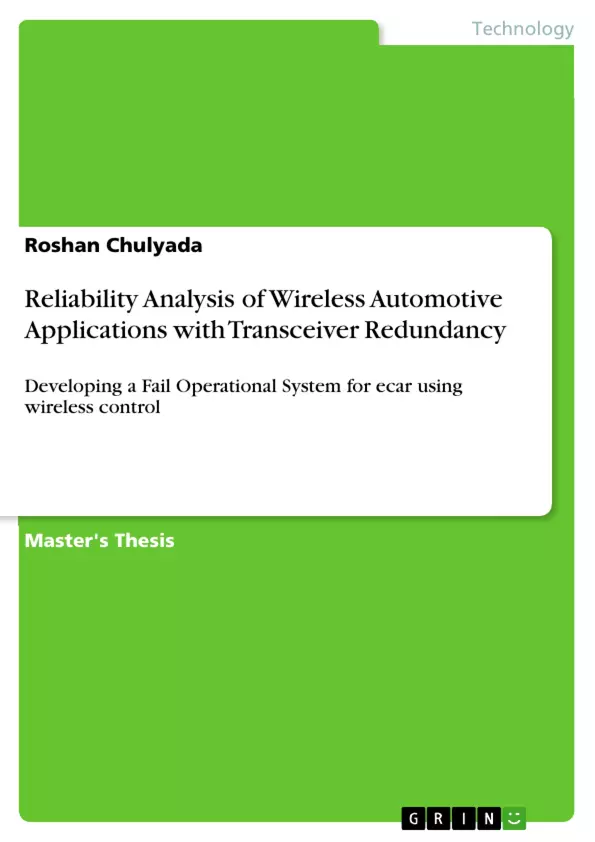In this thesis, the Failure Mode and Effect Analysis (FMEA) methodology is implemented for failure analysis in wireless automotive systems. Reliability analysis is done by using Reliability Block Diagrams (RBD). These analyses are performed to develop redundant systems.
The main focus of this thesis is to make the system behavior fail-operation using wireless technology. The implementation of algorithms and protocol design has been done with an MSPEXP430 board and a CC2520 transceiver to detect single point failures. The implementations were then tested to detect different failure levels successfully.
In this modern age, a car has different functionalities and facilities. The implementation is done by using different actuators, sensors and Electronics Control Units (ECUs). Due to the high complexity of wiring and addition of weight to a car, controlling and maintaining these devices is difficult.
As a solution for these complexities and the problem of weight growth, wireless technology has been used with the TDMA method. The approach for replacing wire by wireless technology may, however, not be secure and reliable.
Inhaltsverzeichnis (Table of Contents)
- 1. Introduction
- 1.1. Motivation
- 1.2. Challenges
- 2. Related Work
- 2.1. Previous Research works.
- 2.2. Differences of Existing Wireless Technologies
- 2.3. Conclusion .
- 3. Requirement Analysis
- 3.1. Existing System Architecture in eCar.
- 3.2. FMEA Concept
- 3.2.1. FMEA Overview
- 3.2.2. FMEA Methodology foundation
- 3.3. FMEA Table .
- 3.4. FMEA Analysis
- 3.5. Conclusion .
- 4. Design of a Fail-Operational Wireless System
- 4.1. Overview of Wireless System with Redundancy
Zielsetzung und Themenschwerpunkte (Objectives and Key Themes)
This thesis explores the challenges of implementing wireless technology in modern cars, specifically addressing the complexities of wiring and weight increase. The goal is to develop a fail-operational wireless system that ensures reliable operation even in the event of single-point failures. This is achieved through a combination of Failure Mode and Effect Analysis (FMEA) for failure analysis and Reliability Block Diagrams (RBD) for reliability analysis.
- Wireless Technology in Automotive Applications
- Failure Mode and Effect Analysis (FMEA)
- Reliability Block Diagrams (RBD)
- Redundant System Design
- Fail-Operational Wireless Systems
Zusammenfassung der Kapitel (Chapter Summaries)
- Chapter 1: Introduction This chapter introduces the motivation behind the work, highlighting the challenges associated with traditional wiring in modern cars. It sets the stage for exploring the potential of wireless technology as a solution.
- Chapter 2: Related Work This chapter delves into existing research on wireless technologies in automotive applications. It examines previous research works and discusses the differences between various wireless technologies.
- Chapter 3: Requirement Analysis This chapter focuses on the existing system architecture in electric cars and introduces the FMEA concept. It details the FMEA methodology and presents a table for analyzing potential failures. Finally, it discusses the FMEA analysis process.
- Chapter 4: Design of a Fail-Operational Wireless System This chapter outlines the design of a wireless system with redundancy to ensure fail-operational behavior. It provides an overview of the system's architecture and functionalities.
Schlüsselwörter (Keywords)
Wireless technology, automotive applications, fail-operational systems, FMEA, reliability analysis, RBD, redundant systems, single-point failures, MSP-EXP430 board, CC2520 transceiver.
- Citar trabajo
- Roshan Chulyada (Autor), 2014, Reliability Analysis of Wireless Automotive Applications with Transceiver Redundancy, Múnich, GRIN Verlag, https://www.grin.com/document/318837



